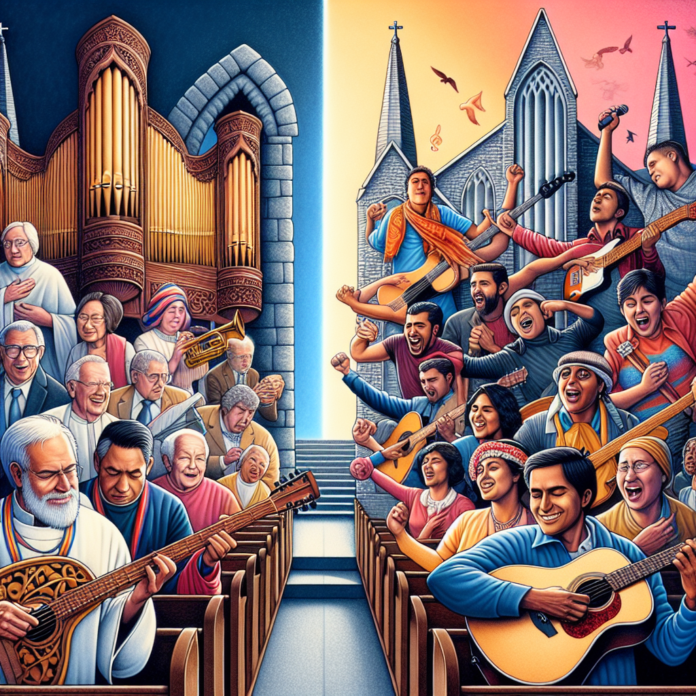Title: Sacred Music at a Crossroads: Why Reformists Hold the Future Over Liturgical Purists
In the ever-evolving landscape of sacred music within the Church, a war is quietly being waged between two camps—Liturgical Purists and Reformists. This conflict isn’t just a battle of melodies and harmonies; it’s a struggle between stagnation and progress, between the dusty echoes of the past and the resonant chords of the future. On one side, the Purists cling tenaciously to their musty hymnals and Gregorian chants, while on the other, Reformists are tirelessly working to infuse the liturgy with renewed fervor and relevance. It is becoming increasingly clear that the future of sacred music lies squarely with the Reformists.
Liturgical Purists, grounded in anachronistic traditions, argue that sacred music should be immutable, adhering strictly to historical forms and ancient renditions. Gregorian chants, plainsong, and 16th-century polyphony form the backbone of their preferred repertoire. These musical selections, while undeniably beautiful in their own right, often fall short of speaking to the contemporary soul. Fans of these archaic forms of music posit that they convey a sense of timelessness and divine continuity. While that might serve the needs of a nostalgic few, it overlooks a crucial detail: the essence of liturgy is its communal nature. Worship is not merely a trip down memory lane but a communal experience, and it demands relevance to resonate with today’s congregation.
The roots of this predicament trace back to the Middle Ages when the Church was essentially a gatekeeper to all cultural and educational endeavors. During this era, sacred music was deeply intertwined with liturgical practices, being governed by strict ecclesiastical jurisdictions. Consider the Council of Trent, convened between 1545 and 1563, which established stringent guidelines for sacred music. Intricate polyphonic compositions were toned down to ensure the clarity of the texts. While these regulations were understandable in their historical context—designed to maintain doctrinal unity and liturgical clarity—they are no longer pertinent in an age where literacy is not confined to the clergy.
In modern times, the Purists’ insistence on sticking rigidly to these ancient forms can be seen as an attempt to maintain ecclesiastical control over a domain that should be more inclusive and dynamic. It’s telling that their resistance almost borders on a phobia of innovation. This mindset reeks of an elitism that has no place in a community-oriented structure like the Church. If liturgical music is supposed to serve the faithful, how can it fulfill its purpose if it remains disconnected from contemporary human experiences?
Reformists, on the other hand, recognize that the world has changed dramatically since Pope Gregory the Great supposedly received Gregorian chants from the Holy Spirit (as legend would have it) in the 6th century. They argue for a liturgical music that adapts, evolves, and most importantly, resonates with modern believers. Imagine the transformative power of a Sunday mass where traditional hymns seamlessly blend with contemporary Christian music, gospel, and even global musical styles. Such a service would speak to the universality of the Christian message, making it more inclusive and relatable.
A hallmark of the Reformation in the 16th century was Martin Luther’s idea that congregational singing should be central to worship. His hymn, "A Mighty Fortress Is Our God," composed in vernacular German and sung by the congregation, revolutionized worship by making it accessible to ordinary believers. This democratization of sacred music was a breath of fresh air, and the Reformists of today are echoing this ethos, seeking to break down barriers created by arcane tradition. They are advocating for music that carries the same revolutionary spirit—songs that congregations can sing from their hearts, songs that bridge the gap between the divine and the daily struggles of the faithful.
Certainly, Vatican II’s "Sacrosanctum Concilium" serves as a historical beacon for this ongoing transformation. Promulgated in 1963, the document called for "active participation" by the laity in the liturgy and welcomed the introduction of local languages and musical forms. In essence, Vatican II was a nod to the need for sacred music that is both meaningful and participatory. Reformists argue correctly that this wasn’t just a temporary adjustment but a foundational shift in the approach to liturgical practices.
Moreover, consider the pastoral implications. In parishes worldwide, dwindling attendance and disengaged youth are critical issues. How can the Church possibly hope to engage new generations when its sacred music is marred by centuries-old rigidity? Reformist liturgical music programs that incorporate more contemporary genres are not only refreshing but essential for the sustenance of the Church community. Modern technology also allows for a plethora of musical expressions. Digital organs, synthesized sounds, and even multimedia presentations can significantly enhance the worship experience, making it more appealing for younger, tech-savvy congregants while retaining its reverent essence.
In conclusion, while Liturgical Purists may romanticize an idealized version of sacred music frozen in time, it is the Reformists who hold the keys to the future. By cultivating an approach that embraces change and inclusivity, the Reformists are ensuring that sacred music will continue to inspire, uplift, and unite believers across generational and cultural divides. The Purists’ commitment to historical forms should not eclipse the ultimate goal of engaging the faithful in meaningful worship. The battle over sacred music is more than a skirmish over melodies; it is a clash between the past and the future, and it is becoming increasingly evident that the future must prevail.
